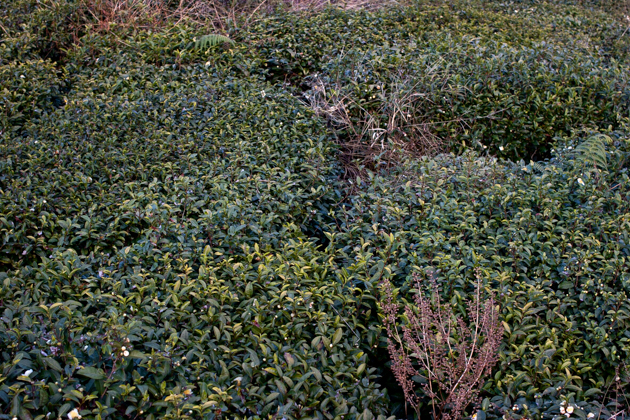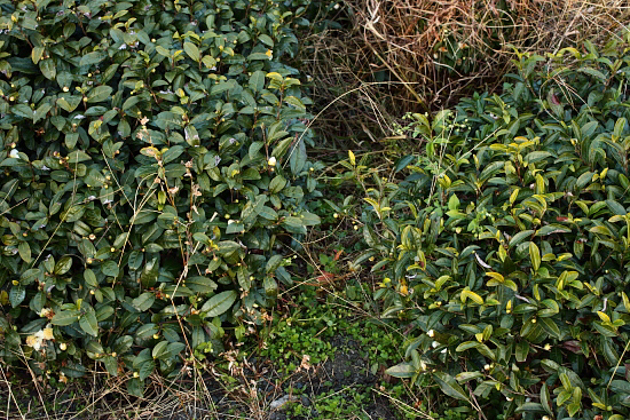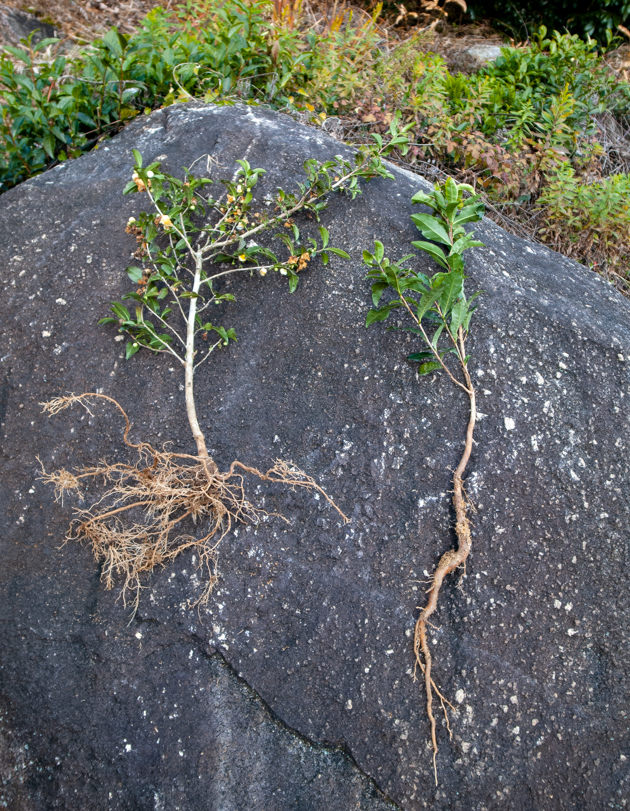- HOME >
- How to choose quality tea
Amazing difference between seedling tea and cultivated tea
- [2020.04.01] Posted By Akira Hojo

Do you know that tea is divided into two groups: cultivated tea propagated by cuttings, and seedling tea grown from seed?
There is actually a big difference between cultivated tea and seedling tea.
What is Cultivar?
The cultivated tea refers to tea with a name of specific cultivar, such as Yabukita, Benifuki, Okumidori, Tie Guan Yin, Rou Gui and Qing Xin Oolong. Among the same cultivar, tea from all tea trees gives same flavour profile because it is propagated with cloning technique.
If tea is grown from seed, it does not inherit the same characteristics as the parent tree.
For example, even if you sow the seed of Fuji apple, it won’t grow into Fuji apple but F1 hybrid, although it may carry certain characteristic of Fuji apple.
Because apples and teas are sexual reproduction, like human, so half of the child’s chromosomes are inherited from the mother (female) and another half from the father (male).
Therefore, if you want to preserve unique characteristics, cutting techniques are used. The cutting technique is also a cloning technique. It will preserve the genetic trait.
Although it is only a small part in China, the cultivar is also preserved by grafting.
Seedling ( Zairai) Tea
On the other hand, tea gown from seeds is called “seedling”.
In the case of Japanese tea, it is commonly called as “Zairai”. In Japan, there are teas with unusual names, such as Yabukita Zairai, which means tea was sown from the seeds of Yabukita cultivar.
As mentioned above, the tea sown from seeds differs from tree to tree. Just as we have brothers and sisters. They have similar characteristics but different. When you visit the tea garden, if the tea trees are grown from seeds, you would observe various shapes of tea leaves in one tea garden, as shown in the following two photos.


Tea trees look the same on the ground but the secret lies underground
There are surprising differences between seedlings and cultivated tea.
The difference lies underground.
If you look at the pictures below, seeing is believing.
On the left is a cultivated tea and on the right is seedling tea.

The roots of the seedling is thick and long. It extends deep into the ground, whereas the roots of cultivated tea are thin, and short like hair, and it spread near the ground surface.
The cultivated tea trees have roots near the ground surface, so they are easy to absorb fertilizer, but because of their shallow roots, they are easy to fall down and lack the ability to absorb minerals deep underground.
Seedling tea is resistant to storms and lasts longer. It is rich in minerals because its roots extend deep underground, so under the same conditions, it make the taste of tea thicker and stronger.
In my experience, Yunnan in China has the world’s most prominent seedling teas. There are many old trees in Yunnan, and most of them are seedling teas.
The Quality of Grafted Tea
The grafting technique is also used for preserving cultivar. Relatively, this technique is common for Phoenix Dan Cong.
If you graft a certain cultivar on an ancient tea tree, what do you think about the taste and the quality of the tea?
Right after grafting, the taste is not very good because the branches try to grow fast.
However, it is said that after about eight years, the quality is reaching to the same level as the mother tree.
The method of grafting is an interesting technique because it preserves the unique flavour characteristics, and the quality is maintained.
Related Articles
How to get the latest update on HOJO Tea?
1. Follow Twitter, 2. Click "Like" on Facebook, and 3. Subscribe in newsletter. You can have the latest tea news from HOJO Tea.
 Subscribe the Newsletter to enjoy the privileges
Subscribe the Newsletter to enjoy the privileges- You may receive a free sample upon purchase, or you may have the priority to purchase special products. So please remember to subscribe our newsletter as well as the social network.
- New Release of High Mountain White Tea
- We are pleased to introduce our High Mountain White Tea, sourced from a unique tea garden with two key features: 1. Located at an altitude of 2200-2300m2. Completely wild and untended The ideal natural conditions of this garden result in tea of exceptional quality, offering a pure and gentle, nourishing taste. High Altitude and Wild …
- New Release of Da Xue Shan Wild White Tea 2024
- We have released the 2024 Da Xue Shan Wild White Tea Loose Leaf. This tea was produced under our direct supervision during our stay in Yunnan Province, ensuring meticulous production management on site. Definition of Wild Tea in Yunnan Province People in Yunnan strongly associate Camellia taliensis with wild tea, regardless of where it is …
NEW ARTICLES
 Why Do Some Teas Taste Astringent? Exploring the Causes and Mechanisms of Astringency
Why Do Some Teas Taste Astringent? Exploring the Causes and Mechanisms of Astringency- Tea can range from having no noticeable astringency to possessing a very strong one. What causes this astringency? This article explores the causes and mechanisms behind astringency in tea. Causes of Astringency Astringency arises from the binding of tea components to proteins in the oral cavity, creating a sensation of tightness or dryness. The tongue …
 The Impact of Heat Sources on Tea Flavor
The Impact of Heat Sources on Tea Flavor- It is widely recognized that the material of a kettle plays an important role in shaping the taste of water for brewing tea. Yet, an often overlooked but equally significant factor is the type of heat source used to boil the water. Different heat sources, whether gas, electric, charcoal, or wood fire, can impart distinct …
 New Release of High Mountain White Tea
New Release of High Mountain White Tea- We are pleased to introduce our High Mountain White Tea, sourced from a unique tea garden with two key features: 1. Located at an altitude of 2200-2300m2. Completely wild and untended The ideal natural conditions of this garden result in tea of exceptional quality, offering a pure and gentle, nourishing taste. High Altitude and Wild …
 New Release of Da Xue Shan Wild White Tea 2024
New Release of Da Xue Shan Wild White Tea 2024- We have released the 2024 Da Xue Shan Wild White Tea Loose Leaf. This tea was produced under our direct supervision during our stay in Yunnan Province, ensuring meticulous production management on site. Definition of Wild Tea in Yunnan Province People in Yunnan strongly associate Camellia taliensis with wild tea, regardless of where it is …
 New Release of Wild Pu-erh Jasmine Pearl
New Release of Wild Pu-erh Jasmine Pearl- Out of curiosity, we decided to create a jasmine tea based on Da Xue Shan Wild Raw Tea. This resulted in an exceptionally rare tea, not only in Japan but also in China. Custom Production Network for Jasmine Tea At our store, we source various types of base teas from different regions during the spring. …
 2024 Overview: Our Yunnan White Tea Quality, Process, and Weather Insights
2024 Overview: Our Yunnan White Tea Quality, Process, and Weather Insights- One of the teas we’ve been focusing on in Yunnan Province is white tea. Historically white tea has been produced in both Fujian Province and Yunnan Province for a long time. While white tea from Fujian Province is well-managed during processing, we are dissatisfied with the quality of the raw materials due to the use …
 Yunnan’s Hospitality Culture: Expressed Through Meals
Yunnan’s Hospitality Culture: Expressed Through Meals- In China, as a form of greeting, it’s common to say “你吃饭了吗?” which means “Have you eaten?” However, in Yunnan Province, the phrase “吃饭” is often used in various situations, more like “Eat, eat,” serving as an invitation to share a meal. Yet, with prolonged exposure to Yunnan, one comes to understand that these meal …
 In Search of Wild Tea: Exploring Mountain Villages in Southwest Lincang, Yunnan
In Search of Wild Tea: Exploring Mountain Villages in Southwest Lincang, Yunnan- We are currently sourcing tea in the southwestern part of Lincang City, Yunnan Province. One of the crucial products for us is wild tea. While tea processing is important, securing the raw materials poses the biggest challenge. Recently, we received information about a new location where wild tea supposedly grows. To verify this, we visited …
 New Release of Anxi Traditional Oolong
New Release of Anxi Traditional Oolong- Anxi, located in Fujian province, China, is celebrated for its Tie Guan Yin tea. However, the Traditional Anxi Oolong from this region boasts a unique fruity aroma, distinguishing it from Tie Guan Yin. Anxi: A Renowned Hub for Oolong Tea Production in China Fujian Province, renowned for its rich tea heritage, boasts several prominent tea-producing …
 Yunnan 2024 Spring Tea Sourcing
Yunnan 2024 Spring Tea Sourcing- Yunnan Province is globally renowned for the exceptional quality of its tea leaves. However, lax production management often presents challenges in achieving the desired tea quality when relying solely on pre-made teas. To address this issue, we have committed to remaining on-site throughout the spring season to closely monitor tea production. We are meticulously inspecting …
Shop Info

Address:Lot No. T-215, 3rd Floor, The Gardens Mall, Mid Valley City, Lingkaran Syed Putra, 59200 Kuala Lumpur
Tel: +603-2287-4537
Business Hour: 10am to 10pm
Category
- New Arrival at HOJO Online Shop
- Featured Articles
- Newsletter
- Types of Tea
- Origin of Tea
- Teapot and Tea Equipment
- Tea Column
- How to enjoy tea
- Tea Processing
- How to choose quality tea
- Tea constituents and functional effect
- Safety of Tea
- Foods
- Tea Business Operation
- Hobby and Outdoor Activity
- Ranking of Tea
- Video
- FAQ
- Media Release
Profile

- AKIRA HOJO
- I invite you to experience my tea selections.I was born in Nagano, Japan. In university, I studied agricultural chemistry, and I have the master degree in food science. I worked in Japanese food industry for 10 years. I involved in R&D, QC and QA. As a factory manager, I implemented ISO9000 series and managed the factory.
- The Art of Tea Magazine
- We posted the article on “The Art of Tea Magazine No.9, the magazine is published in Taiwan. We featured some scientific view about the tetsubin
- New Straits Times
- The Malaysian National Newspaper, New Straits Times featured HOJO Tea on 17-Oct-2007.















